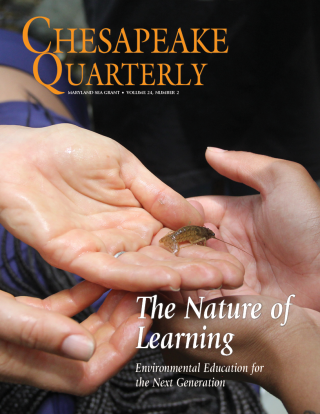Knauss legislative fellowships in Congress help build careers — and they're fun and educational. See our video and fact sheet for details.
The Maryland Sea Grant Bookstore will be closed for the winter holidays from Monday, December 15th to Friday, January 2nd and will not be taking orders during that time.
Resilience and Recovery
.jpg)
On the Chesapeake Bay, nothing’s simple. And that includes efforts to improve the water quality of this famous estuary.
That complexity largely comes down to two scientific concepts: resilience and thresholds.
Resilience refers to an ecosystem’s natural ability to resist big changes, such as a fast improvement or worsening in water quality. A threshold is a tipping point in which an ecosystem suddenly shifts from one state to another. Both concepts can be seen in operation on the Bay.
Resilience: Since the mid-1980s, humans have made concerted, sustained efforts to reduce the nutrients they dump into the Chesapeake Bay. But the Bay, due to biological, chemical, and physical processes, hasn’t recovered as much as many would like.
Thresholds: While the water quality in the Bay had decreased steadily throughout the 1960s, a big drop followed Hurricane Agnes in 1972. The storm wiped out much of the Bay’s underwater grass populations, which were already struggling due to human activities. The populations have not recovered much.
Some scientists suggest that the estuary has entered into an “alternative steady state”— one where underwater grasses are no longer common in the estuary. Instead, the vegetation was replaced by extensive, and often harmful, blooms of algae.
Both resilience and thresholds can slow efforts to clean up the Bay. In other words, once the ecosystem passes a tipping point, it’s difficult to push the ecosystem back to its previous state.
Hope for Recovery
But resilience and thresholds can work to the Bay’s advantage, too. When underwater grass beds are thick and healthy, they can withstand severe storms and scouring.
And once underwater grasses begin growing in an area, they can start to improve the quality of water around them — that makes it easier for even more grasses to grow.
So while efforts to clean up the Bay may deliver unpredictable results, when big changes come, they may come fast.
Maryland Sea Grant supports research that investigates resilience and thresholds in the Bay and how these concepts affect the Chesapeake’s restoration.
To learn more, check out some of our resources:
- Is the Bay Recovery Looking Up, an issue of Chesapeake Quarterly, Maryland Sea Grant's magazine, explores examples of how the push to restore the Chesapeake ecosystem has been successful.
- On the Road to Restoration, an issue of Chesapeake Quarterly, examines how resilience plays a role in Bay restoration.
- Thresholds in the Recovery of Eutrophic Coastal Ecosystems -- A Workshop Report summarizes the results of a workshop where researchers discussed how thresholds may help or slow the Bay’s recovery.





